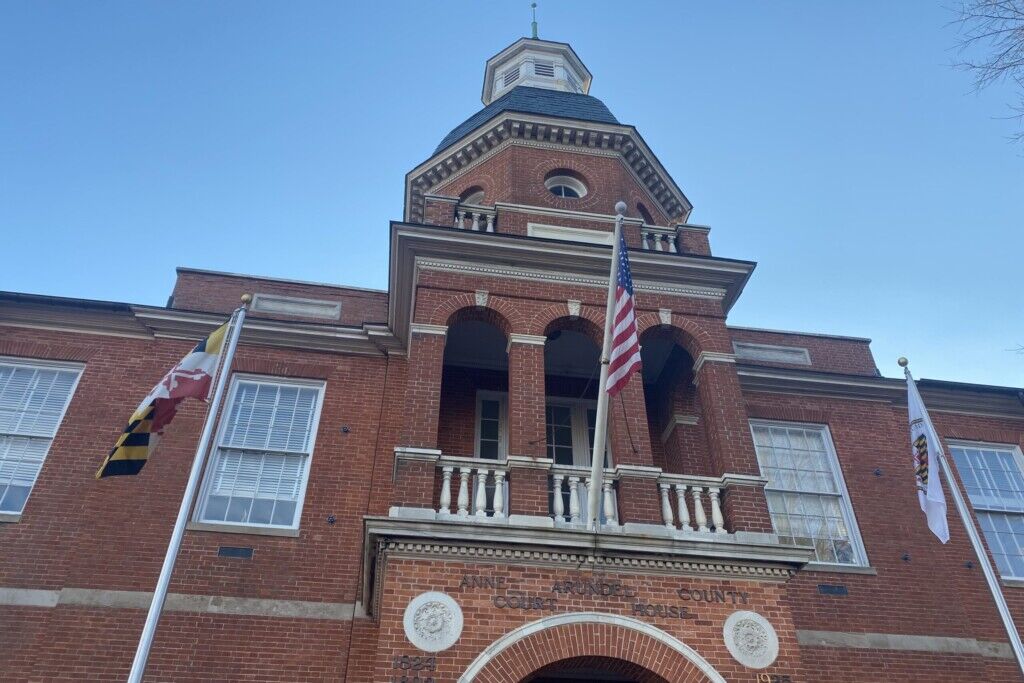This article was republished with permission from WTOP’s news partners at Maryland Matters. Sign up for Maryland Matters’ free email subscription today.

This content was republished with permission from WTOP’s news partners at Maryland Matters. Sign up for Maryland Matters’ free email subscription today.
A judge deferred ruling on a redrawn congressional district map from the Maryland General Assembly on Friday because Gov. Lawrence J. Hogan Jr. (R) has yet to act on that map.
Senior Judge Lynne A. Battaglia said during a hearing in the Anne Arundel County Circuit Court that any ruling she makes on the new districts would have to be in an advisory capacity, and said she would instead issue new findings of fact as the case is appealed to the Maryland Court of Appeals.
The Friday hearing came just a week after Battaglia, a former Court of Appeals judge, struck down the General Assembly’s original congressional map for “extreme partisan gerrymandering” and ordered the legislature to draw a new districting plan with more compact districts.
Battaglia’s ruling set off an unprecedented scramble to draw a new map by the General Assembly: A new map was drafted over the weekend and unveiled Monday; the proposal had a brief hearing Tuesday morning and steamed through the Senate over Republican objections; and received final approval in the House of Delegates on Wednesday. The new map headed to Hogan’s desk Thursday, but the governor hadn’t acted on the map as of the Friday morning hearing.
Battaglia noted Friday that the state already appealed her original ruling to the Maryland Court of Appeals, and said she didn’t have the authority to rule definitively on the new map because it hasn’t been adopted or vetoed by the governor.
Kimball Brace, the president of the redistricting data company Election Data Services who testified on behalf of the state, said he analyzed both the new map and the original map enacted by lawmakers and found the redrawn districts to be significantly more compact.
“Compactness has been taken into account, clearly,” Brace said.
Assistant Attorney General Andrea Trento said the new map contains a similar number of county splits to Maryland’s congressional map from the 1970s and said the new proposal comports with Article III, Section 4 of the Maryland Constitution. Battaglia’s ruling applied that section — a provision that requires legislative districts be compact and respect natural and political boundaries — to congressional districts as well.
Battaglia also found that the new map violates portions of the Maryland Declaration of Rights dealing with free speech, equal protection and “free and fair elections.”
Strider Dickson, an attorney for the plaintiffs in the Szeliga v. Lamone case, took issue with the newly drawn 2nd District’s move into north-central Baltimore south of Towson. That district saw radical shifts between the General Assembly’s original proposal and the redrawn map, and under the new map would extend from Carroll County to Baltimore County and south into Baltimore City. Dickson argued the 2nd District’s extension into the city was unnecessary and drawn to make the district more Democratic.
Trento said the 2nd District move into those northern Baltimore City neighborhoods was meant to ensure the 7th District complies with the federal Voting Rights Act and gives Black voters in the district a chance to elect their candidate of choice. He noted that the 4th District, now contained almost entirely within Prince George’s County, was also drawn to comply with the Voting Rights Act.
Almost all of the 7th District is contained within Baltimore in the redrawn map, along with parts of Baltimore County just west of the city and the area around Dundalk in southeastern Baltimore County.
The new map includes several other consequential changes to the district lines originally passed by lawmakers in December, including a 5th District that no longer hooks north from Southern Maryland to include College Park; a 1st District that no longer crossed the Chesapeake Bay Bridge and becomes solidly Republican; and 6th District that includes all of Frederick County and less of Montgomery County.
Battaglia’s ruling last week followed a four-day trial in the Anne Arundel County Circuit Court in March for a pair of challenges to Maryland’s congressional map. One of those lawsuits, Szeliga v. Lamone, was brought by Republican voters from all eight of Maryland’s congressional districts and contended that the new map violated the state constitution by diluting Republican votes; another challenge, brought by Del. Neil C. Parrott (R-Washington) and the national conservative group Judicial Watch, likewise contended that the map violated the state constitution.
The Attorney General’s office appealed Battaglia’s original ruling to the Maryland Court of Appeals earlier this week. Trento said after the hearing that he couldn’t speak to how Battaglia’s new findings of fact would affect the case in the Court of Appeals, since the state appealed her original tossing out of the congressional map. The redrawn map enacted by lawmakers this week is contingent on the appeal.
The Court of Appeals is already taking up challenges to Maryland’s new legislative districts, with a special magistrate in that case indicating that he would try to submit his report to the court by April 4.
Hogan has appointed five of the Court of Appeals current judges, including Chief Judge Joseph Getty, who faces mandatory retirement in just over two weeks.







